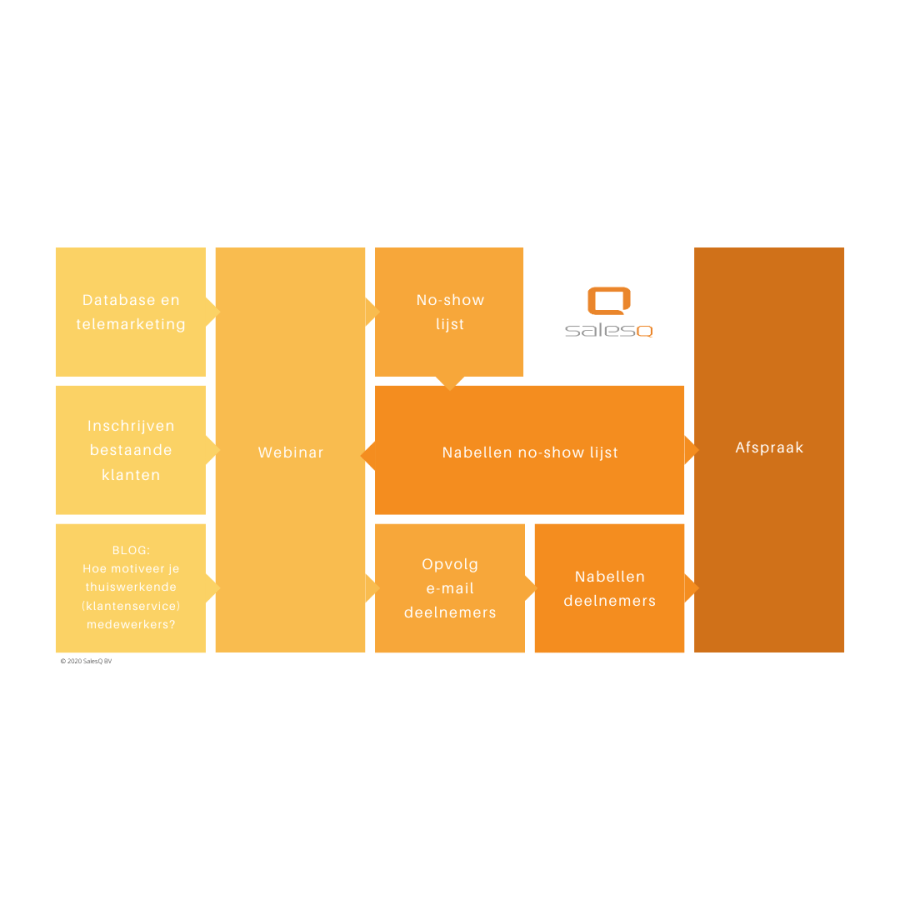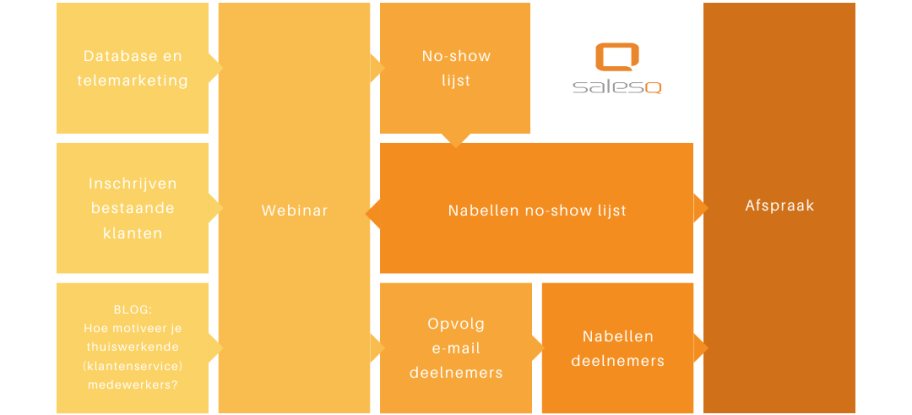Content is king, that has been clear for years. When you have good content, you can earn money with it. It is not without reason that sports, porn and gaming are the pillars of the internet. And everyone has good content and a good story in one way or another. Not something that comes quickly and disappears quickly, but something that has substance and solves an obvious problem in the world. At SalesQ, for example, we are good at opening doors to potential customers. I see that as a specialism, a profession.
Over the years, I've learned that the best way to share your content with potential customers is a webinar. This is because, in addition to being scalable, it can also be made very interactive. In addition, it is easily accessible for people to register and participate. And to share content in an interactive way is the best there is. Just sending a blog, an infographic or a slideshow or placing it on a website is different from a personal explanation, where there is also an opportunity for participants to ask a question and receive an answer directly from a specialist.
Another great thing about organizing a webinar is that there is virtually no risk of loss in terms of costs. Whether there are 5 or 50 participants in the session, it makes little difference in terms of costs. It may even work better for your company with a small group, because you have more contact with the participants. And eventually no one comes, then a webinar is closed again and you do not have to deal with any costs incurred for an expensive location with catering.
Of course there are also some disadvantages when giving a webinar. No matter how easy it is to register, how easy it is not to show up just before the start of the webinar. In addition, it is also difficult to feel whether your story is getting through, because the reaction of the audience is more difficult to gauge. In that respect it feels a bit like a radio show. Ultimately, the appointments and events where you personally speak to each other will of course remain the most valuable, but virtual sessions, including webinars, are an excellent addition. Due to the corona crisis, giving webinars has accelerated, as a result of which everyone has become more used to them and as a result more will be offered online.
Are you interested in organizing your webinar? Here are 11 tips for hosting revenue-generating webinars:
STEP 1) Which software should you use?
There are now countless solutions on the market that all do more or less the same thing. So it doesn't really matter which platform you choose, but through this article you can see how Gartner assesses the different suppliers.
STEP 2) Choose a current and interesting topic
Choose a topic that is concrete, topical, interesting and addresses an essential problem that concerns people. The person giving the webinar must be an absolute specialist on the subject. It is also interesting to have an appealing guest speaker, increasing the value and knowledge of the webinar. Think, for example, of a customer who tells about his experience with you or a well-known person who is seen in the market as an expert.
STEP 3) Give a nice give-away or raffle a great prize
Some people may find it flat or even cheap, but it works really well: giving a gift or raffling off a valuable or meaningful prize. Because let's be honest: everyone likes to get something! It ensures a good experience and will also positively influence the number of registrations. The give-away does not have to be expensive, as long as it represents a certain value: there are companies that, for example, give a wireless access point or a gift voucher for an experience. You can also raffle one valuable gift (annual membership to an app or your own product or service among one of the active participants (for example, ask a question about the topic you are discussing, to see whether participants are also paying attention). participants will certainly stay in the webinar until the end, but make sure that through qualification you can distinguish between the really interested people and those who are only there for the give-away during the webinar, or better yet when registering the webinar.
STEP 4) Do not make the webinar too long. 30 to 40 minutes is enough
Most people's concentration arc is about 45 minutes, so a webinar should certainly not last longer. Precisely because it is a virtual session, a longer webinar will cause people to wander off and not participate anymore. Participants will also have more time for a session of 30 to 40 minutes than a session of 60 to 90 minutes.
STEP 5) Schedule a number of webinars over a longer period
Not everyone who is interested in the topic will be able to do it exactly when you hold that one webinar, so the more options you offer, the greater the total number of registrations. You'd rather have 8 webinars with 10 attendees than one with 50 attendees, right? You will also notice that after the first webinar you will get better and better at it and it will cost you less and less preparation time
STEP 6) Create a professional invitation
A professional-looking invitation that you can easily share via the social media channels will give you 20% more registrations. Think of a nicely formatted ad, but a video nowadays works just as well if not better. In the invitation, clearly state what the webinar is about, what they can expect and what it can bring to the participant. In addition, it is crucial to create a registration page so that you can keep track of who registers. In this way you not only collect personal data from potential customers, but you can also send reminder emails to increase attendance
STEP 7) Take a call out to register as many people as possible
Always do a call-out to personally invite people and register for the webinar. When your topic is interesting enough, it always has a positive effect and the number of registrations can even increase by 50%. What is very important when doing a call action is that the people calling:
- appear professional;
- do not call based on a script but ask the prospect in an authentic and neat way whether the topic of the webinar fits and
- Finally, politely ask if the prospect is interested in participating in the webinar.
Spend enough time to put together a good database. It is also highly recommended to call everyone who has registered. When you do this 1 or 2 days before the webinar, participants value this (professional follow-up) and they know that you are counting on them and the no-show will quickly be 25% lower. Also read the articles “You can learn cold calling” and “How do you ensure a GDPR-proof customer base?” for tips on this.
STEP 8) Make the webinar interactive
Forget the old-school informative presentations and make the webinar interactive. With the different platforms that exist, it is possible to:
- share videos;
- allow participants to ask questions via chat or
- to ask questions to the participants that can be answered by means of the poll function in the software. The poll results can then be shared with the rest of the group, which can lead to interesting discussion points.
If the group is smaller than 15 people, it is also possible to give everyone the opportunity to ask a question verbally.
STEP 9) End with a clear call-to-action (CTA)
At the end of every webinar it is important to ensure a good and clear call-to-action. With this you help your prospects to make the next step in the sales cycle easier and you increase the chance that sooner or later you will get down to business. Here are a few examples:
- Filling out a questionnaire to gather more information about the prospect's situation
- Offering a free quick scan for participating
- Making a physical or virtual follow-up appointment
- Offering a one-time discount only for webinar participants
For example, there are many fun and creative call-to-actions, but please note that it must always be a logical, attractive and accessible step.
STEP 10) Proper follow-up is crucial
It is good to send a follow-up email after the webinar. First of all, thank the participants for their attendance, share the link to the recording and/or to the slides you shared and ask if they would like to take a moment to complete a survey to rate the webinar. This gives you good insights and the chance to do even better the next webinar. Because you, as a company, are vulnerable with a satisfaction survey, you can count on extra sympathy.
The recording, the results of the polls and the satisfaction survey are all excellent content to share online, as well as the winner of a possible draw. Share this valuable content as soon as possible after the webinar, because that way you will attract new interested parties for the next webinar.
STEP 11) Last but not least: always call afterwards for a concrete conversion!
After 1 or 2 days, the timing is right to give all participants a call asking what they thought of the webinar and whether it is possible to make a follow-up appointment. Provided the webinar was of good quality and you have been able to come up with something new and relevant, you will certainly get interesting leads from these follow-up calls.
Don't forget to call the people who registered but were not present during the webinar. In the end, they did show an interest in the subject and you can follow that up. For example, ask for the reason they were unable to attend and invite them directly to attend the next webinar. Or even better, make a 1 on 1 (video) appointment right away. You will notice that despite the no-show there is still a good conversion to be achieved. People might feel a little guilty that they didn't come, especially when they realize that you and your team have put so much time and effort into it. If the topic is somewhat relevant to them, you will be able to count on sympathy and therefore conversions.
We wish you the best of luck with organizing your webinar! If you would like more support in organizing a webinar, please contact SalesQ on +31 23 7113200 or info@salesq.nl.
Dé 11 stappen voor een webinar die omzet oplevert




